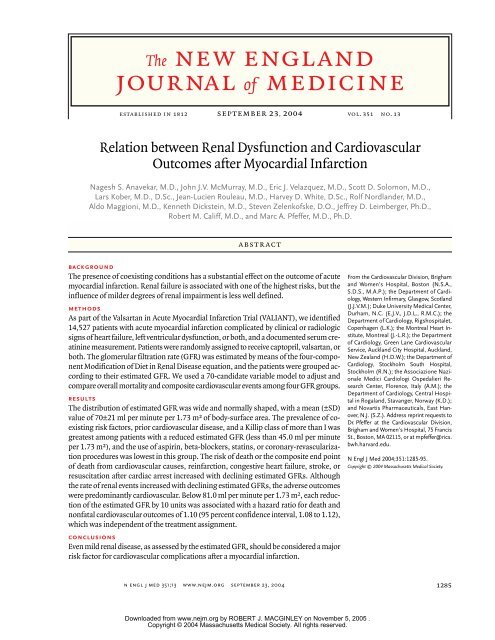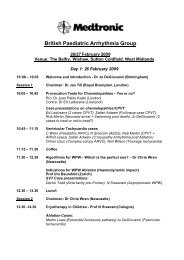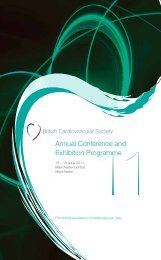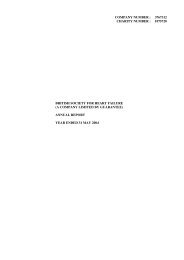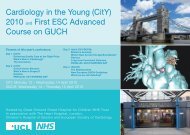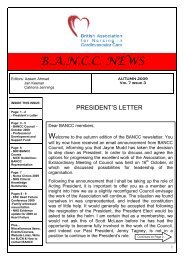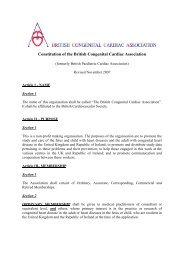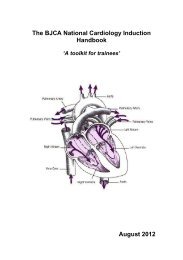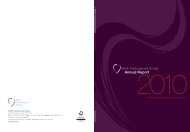Anavekar NS, McMurray JJV, Velazquez EJ, Solomon SD, Kober L ...
Anavekar NS, McMurray JJV, Velazquez EJ, Solomon SD, Kober L ...
Anavekar NS, McMurray JJV, Velazquez EJ, Solomon SD, Kober L ...
- No tags were found...
You also want an ePaper? Increase the reach of your titles
YUMPU automatically turns print PDFs into web optimized ePapers that Google loves.
The new englandjournal of medicineestablished in 1812 september 23, 2004 vol. 351 no. 13Relation between Renal Dysfunction and CardiovascularOutcomes after Myocardial InfarctionNagesh S. <strong>Anavekar</strong>, M.D., John J.V. <strong>McMurray</strong>, M.D., Eric J. <strong>Velazquez</strong>, M.D., Scott D. <strong>Solomon</strong>, M.D.,Lars <strong>Kober</strong>, M.D., D.Sc., Jean-Lucien Rouleau, M.D., Harvey D. White, D.Sc., Rolf Nordlander, M.D.,Aldo Maggioni, M.D., Kenneth Dickstein, M.D., Steven Zelenkofske, D.O., Jeffrey D. Leimberger, Ph.D.,Robert M. Califf, M.D., and Marc A. Pfeffer, M.D., Ph.D.abstractbackgroundThe presence of coexisting conditions has a substantial effect on the outcome of acutemyocardial infarction. Renal failure is associated with one of the highest risks, but theinfluence of milder degrees of renal impairment is less well defined.methodsAs part of the Valsartan in Acute Myocardial Infarction Trial (VALIANT), we identified14,527 patients with acute myocardial infarction complicated by clinical or radiologicsigns of heart failure, left ventricular dysfunction, or both, and a documented serum creatininemeasurement. Patients were randomly assigned to receive captopril, valsartan, orboth. The glomerular filtration rate (GFR) was estimated by means of the four-componentModification of Diet in Renal Disease equation, and the patients were grouped accordingto their estimated GFR. We used a 70-candidate variable model to adjust andcompare overall mortality and composite cardiovascular events among four GFR groups.resultsThe distribution of estimated GFR was wide and normally shaped, with a mean (±<strong>SD</strong>)value of 70±21 ml per minute per 1.73 m 2 of body-surface area. The prevalence of coexistingrisk factors, prior cardiovascular disease, and a Killip class of more than I wasgreatest among patients with a reduced estimated GFR (less than 45.0 ml per minuteper 1.73 m 2 ), and the use of aspirin, beta-blockers, statins, or coronary-revascularizationprocedures was lowest in this group. The risk of death or the composite end pointof death from cardiovascular causes, reinfarction, congestive heart failure, stroke, orresuscitation after cardiac arrest increased with declining estimated GFRs. Althoughthe rate of renal events increased with declining estimated GFRs, the adverse outcomeswere predominantly cardiovascular. Below 81.0 ml per minute per 1.73 m 2 , each reductionof the estimated GFR by 10 units was associated with a hazard ratio for death andnonfatal cardiovascular outcomes of 1.10 (95 percent confidence interval, 1.08 to 1.12),which was independent of the treatment assignment.conclusionsEven mild renal disease, as assessed by the estimated GFR, should be considered a majorrisk factor for cardiovascular complications after a myocardial infarction.From the Cardiovascular Division, Brighamand Women’s Hospital, Boston (N.S.A.,S.D.S., M.A.P.); the Department of Cardiology,Western Infirmary, Glasgow, Scotland(J.J.V.M.); Duke University Medical Center,Durham, N.C. (E.J.V., J.D.L., R.M.C.); theDepartment of Cardiology, Rigshospitalet,Copenhagen (L.K.); the Montreal Heart Institute,Montreal (J.-L.R.); the Departmentof Cardiology, Green Lane CardiovascularService, Auckland City Hospital, Auckland,New Zealand (H.D.W.); the Department ofCardiology, Stockholm South Hospital,Stockholm (R.N.); the Associazione NazionaleMedici Cardiologi Ospedalieri ResearchCenter, Florence, Italy (A.M.); theDepartment of Cardiology, Central Hospitalin Rogaland, Stavanger, Norway (K.D.);and Novartis Pharmaceuticals, East Hanover,N.J. (S.Z.). Address reprint requests toDr. Pfeffer at the Cardiovascular Division,Brigham and Women’s Hospital, 75 FrancisSt., Boston, MA 02115, or at mpfeffer@rics.bwh.harvard.edu.N Engl J Med 2004;351:1285-95.Copyright © 2004 Massachusetts Medical Society.n engl j med 351;13 www.nejm.org september 23, 2004 1285Downloaded from www.nejm.org by ROBERT J. MACGINLEY on November 5, 2005 .Copyright © 2004 Massachusetts Medical Society. All rights reserved.
The new england journal of medicinestatistical analysisPatients were categorized according to the estimatedGFR at baseline with the use of the four-componentMDRD equation incorporating age, race, sex,and serum creatinine level 13 :estimated GFR=186¬(serum creatinine level[in milligrams per deciliter]) ¡1.154¬(age [in years]) ¡0.203 .For women and blacks, the product of this equationwas multiplied by a correction factor of 0.742and 1.21, respectively. 13 A total of 14,527 patientshad baseline creatinine values recorded a mean of4.9 days after myocardial infarction. The distributhenational kidney foundationdefines chronic kidney disease as persistentkidney damage, as reflected by a glomerularfiltration rate (GFR) of less than 60.0 mlper minute per 1.73 m 2 of body-surface area formore than three months. 1 This definition encompassesat least 11 million people in the United States,and the number is rising. 2,3 Community studies reveala rising prevalence of cardiovascular diseasewith declining renal function. 4-6 Patients with endstagerenal disease, as defined by a GFR of less than10.0 ml per minute per 1.73 m 2 , are at high risk forcardiovascular events, especially if they are receivingrenal-replacement therapy. 7 More than 50 percentof deaths among patients with end-stage renaldisease are due to cardiovascular events. 8The risk of subsequent cardiovascular events ishigher among patients with chronic kidney diseasethan among persons with normal renal function. 9,10The two-year mortality rate after myocardial infarctionamong patients with end-stage renal diseaseis approximately 50 percent — twice the mortalityrate after myocardial infarction in the general population.11 Possible explanations include higher proportionsof coronary risk factors and lower use ofstrategies to modify cardiovascular risk. 1Limited information exists on the risks associatedwith lesser degrees of chronic kidney diseasein patients who have had an acute myocardial infarction.The majority of what is known relates tothe serum creatinine level, which is an insensitiveindicator of renal function. Furthermore, the smallnumber of studies conducted have had relativelyshort follow-up periods and have concentrated onfatal outcomes. Finally, only a small proportion ofpatients in these studies have been taking an inhibitorof the renin–angiotensin system. These drugsreduce cardiovascular risk and are nephroprotective.We evaluated the prevalence of chronic kidneydisease using the estimated GFR in high-risk survivorsof myocardial infarction to determine whetherchronic kidney disease continues to be an independentpredictor of nonfatal and fatal adverse outcomesin patients who are receiving inhibitors ofthe renin–angiotensin system.methodspatientsThe Valsartan in Acute Myocardial Infarction Trial(VALIANT) was a multinational, double-blind, randomized,controlled trial with three parallel treatmentgroups that compared the efficacy and safetyof long-term treatment with valsartan, captopril,and the two in combination. Eligible patients includedmen and women 18 years of age or olderwho had had an acute myocardial infarction (0.5 to12 days previously) complicated by clinical or radiologicsigns of heart failure, left ventricular systolicdysfunction, or both. 12 Patients with a baseline serumcreatinine level of at least 2.5 mg per deciliter(221 µmol per liter) were excluded. The median durationof follow-up was 24.7 months, with a maximumof 16 visits. All patients gave their written informedconsent, and the protocol was approved bythe appropriate institutional review boards.treatmentEligible patients were randomly assigned in a 1:1:1ratio to receive valsartan (target dose, 160 mg twicedaily), captopril (target dose, 50 mg three times daily),or a combination of valsartan and captopril (targetdose, 80 mg twice daily and 50 mg three timesdaily, respectively). 12gfr measurementThe GFR is considered most suitable for quantifyingrenal function. 13 Practical limitations exist inmeasuring GFR directly, especially in acutely illpatients. Several reliable equations incorporatingclinical variables to estimate the GFR are available;we used the Modification of Diet in Renal Disease(MDRD) equation. 13outcomesThe primary end point was death from any cause. 12Secondary end points included death from cardiovascularcauses, congestive heart failure, recurrentmyocardial infarction, resuscitation after cardiacarrest, stroke, and a composite of these. 121286n engl j med 351;13 www.nejm.org september 23, 2004Downloaded from www.nejm.org by ROBERT J. MACGINLEY on November 5, 2005 .Copyright © 2004 Massachusetts Medical Society. All rights reserved.
enal dysfunction and cardiovascular outcomes after myocardial infarctiontion of the estimated GFR was divided into fourcategories (less than 45.0, 45.0 to 59.9, 60.0 to 74.9,and at least 75.0 ml per minute per 1.73 m 2 ), incorporatingthe guidelines of the National KidneyFoundation. 1 Clinical outcomes included deathfrom any cause and the cardiovascular compositeend point. The estimated GFR is presented in categoriesfor descriptive purposes but was a continuousmeasure in statistical tests. Baseline characteristicswere analyzed with the use of Spearman’srank correlation and the Wilcoxon rank-sum testfor continuous and categorical variables, respectively.Cox proportional-hazards modeling was used tocompare clinical outcomes. Candidate variables included70 baseline characteristics. For continuousvariables, the Cox-model assumption of linearitybetween the variable and the logarithmic hazard ratioof the outcome was assessed by fitting restrictedcubic splines in the model. These functions weregraphically and statistically examined, and appropriatetransformations were applied. 14 Stepwiseelimination and backward selections were used toselect the most parsimonious set of predictive variables.Treatment effects were then added to obtainthe model reported here (see the Appendix). Kaplan–Meierestimates, stratified according to the estimatedGFR, for death from any cause and the cardiovascularcomposite end point were determinedand presented as event curves. All P values weretwo-sided, and a P value of less than 0.05 was consideredto indicate statistical significance. Analyseswere performed with the use of SAS software (version6.0).resultsbaseline characteristicsThe baseline estimated GFR for the 14,527 patientswas normally distributed (Fig. 1). The mean(±<strong>SD</strong>) estimated GFR was 70.2±21.3 ml per minuteper 1.73 m 2 (range, 7.6 to 139.8). A total of 5560(38.3 percent) patients had an estimated GFR ofat least 75.0 ml per minute per 1.73 m 2 , 4105 (28.3percent) had an estimated GFR of 60.0 to 74.9 mlper minute per 1.73 m 2 , 3218 (22.2 percent) had anestimated GFR of 45.0 to 59.9 ml per minute per1.73 m 2 , and 1644 (11.3 percent) had an estimatedGFR of less than 45.0 ml per minute per 1.73 m 2 .Despite the use of a serum creatinine level of atleast 2.5 mg per deciliter as an exclusion criterion,4882 (33.6 percent) patients met the estimated GFRcriteria for chronic kidney disease. The absoluteNo. of Patients12001000800600400200
The new england journal of medicineTable 1. Baseline Characteristics of the Patients According to the Estimated GFR.*CharacteristicGFR,
enal dysfunction and cardiovascular outcomes after myocardial infarctionA B0.6GFR,
The new england journal of medicineEstimated Event Rate (%)40302010estimated GFR of less than 45.0 ml per minuteper 1.73 m 2 .There was a wide spectrum of risk across thecategories of estimated GFR, with early divergenceof the Kaplan–Meier curves for the composite endpoint (Fig. 2B). The composite cardiovascular endpoint and its individual components were morecommon among patients with a lower estimatedGFR at baseline than among those with the highestestimated GFR (P
enal dysfunction and cardiovascular outcomes after myocardial infarctionTable 2. Hazard Ratios for Death and Composite Outcomes According to the Estimated GFR and Creatinine Levels at Baseline.*GFR, >75.0 ml/min/1.73 m 2 ;Creatinine 0.9±0.1 mg/dl(N=5560)GFR, 60.0–74.9 ml/min/1.73 m 2 ;Creatinine, 1.1±0.1 mg/dl(N=4105)GFR, 45.0–59.9 ml/min/1.73 m 2 ;Creatinine, 1.3±0.2 mg/dl(N=3218)GFR,
The new england journal of medicineHazard Ratio for Death from Any Cause141210864200 20 40 60 80 100 120 140Estimated GFR (ml/min/1.73 m 2 )Figure 4. Unadjusted Hazard Ratio for Death from Any Cause, According to theEstimated GFR at Baseline.The estimated hazard ratio (middle curve) is shown with the 95 percent confidencelimits (upper and lower curves).renal function was independently associated withan increased risk of death and cardiovascularevents. 21-23 Despite the fact that our study differedfrom these studies, in that all patients received inhibitorsof the renin–angiotensin system and managementwas more modern, we found similar associationsbetween renal function and the risk ofdeath and adverse cardiovascular outcomes.The use of Framingham scores underestimatescardiovascular risk in patients with chronic kidneydisease, 24 suggesting that other factors are alsoinfluential. After adjustment, a low estimated GFRwas independently associated with an increasedrisk of death and complications from cardiovascularcauses, reinforcing the concept that renal diseaseis a risk factor for cardiovascular events. Severalstudies have suggested that cutoff values foran estimated GFR of less than 60.0 ml per minuteper 1.73 m 2 are predictive of adverse cardiovascularoutcomes. 13,24,25 Our findings suggest that patientswith renal impairment already have an increasedrisk of cardiovascular events and that thisrisk increases with worsening renal function.Mechanisms by which renal dysfunction increasescardiovascular risk are under investigation.The progressive increase in cardiovascular riskwith worsening estimated GFR is partly explainedby factors associated with renal decline, includinganemia, oxidative stress, derangements in calcium–phosphatehomeostasis, inflammation, andconditions promoting coagulation, all of which areassociated with accelerated atherosclerosis andendothelial dysfunction. 2-5 Other nonconventionalrisks that progressively increase with renal declineinclude albuminuria, proteinuria, homocysteinemia,and elevated uric acid levels. 1,4The high prevalence of traditional coronary riskfactors among patients with chronic kidney diseasehas been noted previously. 1,4 Patients with renalimpairment have multiple coexisting conditionsand angiographic evidence of severe and diffusecoronary artery disease. 18 In our cohort, the proportionsof patients with hypertension and diabetesmellitus increased with worsening estimatedGFR. Many coronary risk factors, particularly diabetesmellitus and hypertension, are establishedpredictors for the progression of renal disease. 4Synergism exists when conventional coronary riskfactors perpetuate renal disease, and progressiverenal decline increases the potency of such riskfactors.We found that older age and female sex wereassociated with a worsening estimated GFR. As inmost studies of patients with myocardial infarction,the proportion of women was greater in the olderage groups. By design, these variables reduce theestimated GFR when the MDRD equation is used,explaining the observed bias. However, several studieshave documented age as a risk factor for cardiovascularand renal disease. 3,5The proportion of patients with chronic kidneydisease who receive appropriate risk-factor modificationand intervention is lower than in the generalpopulation, a concept termed “therapeutic nihilism.”2 Many databases and registries have shownthat this parallels worsening renal function. 26,27Among patients with end-stage renal disease, whoare known to be at extreme risk for cardiovascularevents, less than 50 percent are taking a combinationof aspirin, beta-blockers, angiotensinconverting–enzymeinhibitors, and statins. 28,29 Inour study, patients in the lowest tier of renal functionwere the least likely to receive risk-modifyingcardiovascular medications and to undergo coronaryrevascularization. Potential reasons includeconcern about worsening renal function and therapy-relatedtoxic effects related to reduced clearance.1,16,30,31 However, studies show that, whenappropriately monitored, cardiovascular medicationsand coronary interventional strategies usedin the general population can safely be administeredto those with renal impairment and yield1292n engl j med 351;13 www.nejm.org september 23, 2004Downloaded from www.nejm.org by ROBERT J. MACGINLEY on November 5, 2005 .Copyright © 2004 Massachusetts Medical Society. All rights reserved.
enal dysfunction and cardiovascular outcomes after myocardial infarctionsimilar benefits. 24,25,32-36 Our understanding ofthe efficacy and safety of cardiovascular medicationsand interventional strategies in these patientsis limited, and many cardiovascular trials have excludedpatients with renal disease. 37 Greater effortsare needed to reduce this therapeutic gap.Blockade of the renin–angiotensin system witheither angiotensin-converting–enzyme inhibitorsor angiotensin-receptor blockers reduces the progressionof renal disease. 11,38 Although dual blockademay provide more renal benefit than monotherapy,data are limited. 39 Whether improvements inrenal function translate into improved cardiovascularrisk is not clearly understood. 40,41 In VALIANT,all patients received effective inhibitors of the renin–angiotensinsystem, yet a lower baseline estimatedGFR was still associated with adverse cardiovascularoutcomes. Although patients with renaldysfunction are at risk for adverse cardiovascularand renal outcomes, 1 the predominant clinical effectof chronic kidney disease is on cardiovascularevents. 11 The results of our study support suchfindings: the risk of hospitalization for renal causesincreased with worsening estimated GFR, andthe absolute risk was still significantly lower thanthe risk of cardiovascular events. In terms of cardiovascularoutcomes, VALIANT documented thatvalsartan monotherapy had the same therapeuticbenefits as captopril, and the combination increasedthe rate on discontinuation of treatment withoutfurther improving survival. 12 The absence of an interactionbetween treatment and the baseline estimatedGFR may reflect the fact that the three approachesto the inhibition of the renin–angiotensinsystem have similar effects. However, this does notcompletely eliminate the association of baselineestimated GFR with cardiovascular outcomes. Inthe absence of the use of a placebo group, we cannotspeak about what this effect may be.Our study has several limitations. First, we cannotcomment on the effect of the duration of renaldysfunction on the risk of adverse cardiovascularoutcomes. Second, we did not address the influenceof changes in renal function on risk, possiblyrelated to therapy. Third, we could not evaluate therole of nephropathy induced by contrast mediumadministered before serum creatinine was measured.Fourth, although the MDRD equation is areliable means of estimating the GFR, it has limitations,because the serum creatinine level is influencedby nonrenal factors; the accuracy of the useof the MDRD equation for nonwhite populationsother than blacks is unknown. Finally, we did notmeasure the rates of urinary albumin or proteinexcretion, factors that may drive the documentedindependent effect of the baseline estimated GFRon cardiovascular outcomes. Other renal-specificfactors that were not included in our model mayalso change the influence of the estimated GFR oncardiovascular outcomes.The presence of renal impairment that meetsthe criteria for chronic kidney disease is becomingcommon and is a significant independent risk factorfor cardiovascular events among patients whohave had a myocardial infarction complicated byheart failure, left ventricular systolic dysfunction,or both, as compared with patients with preservedrenal function. This risk is progressive; we foundthat below 81.0 ml per minute per 1.73 m 2 , each10-unit reduction in the baseline estimated GFRwas associated with a 10 percent increase in the relativerisk of death or nonfatal cardiovascular complications.The proportions of adverse renal eventswere still relatively small; patients have a higherrisk of cardiovascular events than adverse renal outcomes.Among patients who have had a myocardialinfarction, any degree of preexisting renal impairmentshould be considered a potent, independent,and easily identifiable risk factor for cardiovascularcomplications.Supported by a grant from Novartis Pharmaceuticals.Drs. Pfeffer and <strong>McMurray</strong> report having served as consultantsfor or having received honorariums from Novartis, AstraZeneca,Bristol-Myers Squibb, Takeda, and Merck. Dr. Maggioni reportshaving served as a consultant for or having received honorariumsfrom Novartis and AstraZeneca. Drs. Califf, <strong>Solomon</strong>, <strong>Velazquez</strong>,and Rouleau report having served as consultants for or having receivedhonorariums from Novartis. Dr. Zelenkofske is an employeeof Novartis and has stock equity in the company. Dr. White reportsreceiving a research grant from Novartis. Dr. Pfeffer is named as acoinventor on a patent awarded to the Brigham and Women’s Hospitalregarding the use of inhibitors of the renin–angiotensin systemin selected survivors of myocardial infarction; there is a licensingagreement between Novartis Pharmaceuticals and the Brigham andWomen’s Hospital that is not linked to sales.appendixThe following variables were used in the final multivariable models (asterisks denote terms that were kept in the final cardiovascular-eventsmodels, and daggers terms that were kept in the final mortality model):Continuous — age (in years),*† height (in centimeters), weight (in kilograms),*† systolic blood pressure (in millimeters of mercury),diastolic blood pressure (in millimeters of mercury), heart rate (in beats per minute),*† pulse pressure,*† mean arterial pressure, time torandomization (in hours), and estimated GFR (in milliliters per minute per 1.73 m 2 )*†; categorical — demographic: white race,* sex,* geo-n engl j med 351;13 www.nejm.org september 23, 20041293Downloaded from www.nejm.org by ROBERT J. MACGINLEY on November 5, 2005 .Copyright © 2004 Massachusetts Medical Society. All rights reserved.
The new england journal of medicinegraphic region,*† and treatment assignment*†; coronary risk factors: presence or absence of hypertension,* diabetes mellitus,* dyslipidemia,and smoking (current*† or previous*); medical history: presence or absence of angina pectoris,*† unstable angina,* myocardial infarction,*†heart failure,*† transient ischemic attacks,* stroke,*† peripheral vascular disease,*† atrial fibrillation, renal disease, pulmonarydisease,*† alcohol abuse,† cancer, hospitalizations within the prior six months,*† angioplasty, coronary-artery bypass grafting,* and animplantable defibrillator; procedures or events from the time of the qualifying myocardial infarction to randomization: presence or absenceof coronary angiography, primary angioplasty,*† thrombolysis,*† angioplasty,*† coronary-artery bypass grafting,*† pacemaker, implantabledefibrillator, intraaortic balloon pump, angina, heart failure,*† atrial fibrillation,*† ventricular fibrillation, ventricular tachycardia, renalinsufficiency,*† dyslipidemia,* hypertension, and diabetes*†; and characteristics at randomization: Killip class*† and presence or absenceof anterior myocardial infarction,*† inferior myocardial infarction, left bundle-branch block,*† Q waves on electrocardiograms, andradiologic evidence of heart failure.references1. National Kidney Foundation. KidneyDisease Outcome Quality Initiative (K/DOQI)clinical practice guidelines for chronic kidneydisease: evaluation, classification, andstratification. Am J Kidney Dis 2002;39:Suppl 1:S1-S266.2. United States Renal Data System. USRDS1999 annual data report. Bethesda, Md.:National Institute of Diabetes and Digestiveand Kidney Diseases, 1999. (Also available athttp://www.usrds.org/adr_1999.htm.)3. McCullough PA. Cardiorenal risk: animportant clinical intersection. Rev CardiovascMed 2002;3:71-6.4. Luft FC. Renal disease as a risk factor forcardiovascular disease. Basic Res Cardiol2000;95:Suppl 1:I72-I76.5. Foley RN, Parfrey PS, Sarnak MJ. Epidemiologyof cardiovascular disease in chronicrenal disease. J Am Soc Nephrol 1998;9:Suppl:S16-S23.6. Sarnak MJ, Levey AS. Cardiovasculardisease and chronic renal disease: a new paradigm.Am J Kidney Dis 2000;35:Suppl 1:S117-S131.7. Chertow GM, Normand SLT, Silva LR,McNeil BJ. Survival after acute myocardialinfarction in patients with end-stage renaldisease: results from the Cooperative CardiovascularProject. Am J Kidney Dis 2000;35:1044-51.8. Herzog CA, Ma JZ, Collins AJ. Poor longtermsurvival after acute myocardial infarctionamong patients on long-term dialysis.N Engl J Med 1998;339:799-805.9. Wright RS, Reeder GS, Herzog CA, etal. Acute myocardial infarction and renaldysfunction: a high-risk combination. AnnIntern Med 2002;137:563-70.10. Al Suwaidi J, Reddan DN, Williams K,et al. Prognostic implications of abnormalitiesin renal function in patients with acutecoronary syndromes. Circulation 2002;106:974-80.11. Sarnak MJ, Levey AS, Schoolwerth AC,et al. Kidney disease as a risk factor for developmentof cardiovascular disease: a statementfrom the American Heart AssociationCouncils on Kidney in Cardiovascular Disease,High Blood Pressure Research, ClinicalCardiology, and Epidemiology and Prevention.Hypertension 2003;42:1050-65.12. Pfeffer MA, <strong>McMurray</strong> JJ, <strong>Velazquez</strong> <strong>EJ</strong>,et al. Valsartan, captopril, or both in myocardialinfarction complicated by heart failure,left ventricular dysfunction, or both. N EnglJ Med 2003;349:1893-906. [Erratum, N EnglJ Med 2004;350:203.]13. Levey AS, Bosch JP, Lewis JB, Greene T,Rodgers N, Roth D. A more accurate methodto estimate glomerular filtration rate fromserum creatinine: a new prediction equation.Ann Intern Med 1999;130:461-70.14. Lee KL, Woodlief LH, Topol <strong>EJ</strong>, et al. Predictorsof 30-day mortality in the era ofreperfusion for acute myocardial infarction:results from an international trial of 41,021patients. Circulation 1995;91:1659-68.15. Chobanian AV, Bakris GL, Black HR,et al. The Seventh Report of the Joint NationalCommittee on Prevention, Detection, Evaluation,and Treatment of High Blood Pressure:the JNC 7 report. JAMA 2003;289:2560-72. [Erratum, JAMA 2003;290:197.]16. Walsh CR, O’Donnell CJ, Camargo CAJr, Giugliano RP, Lloyd-Jones DM. Elevatedserum creatinine is associated with 1-yearmortality after acute myocardial infarction.Am Heart J 2002;144:1003-11.17. Shlipak MG. Pharmacotherapy of heartfailure in patients with renal insufficiency.Ann Intern Med 2003;138:917-24.18. McCullough PA. Beyond serum creatinine:defining the patient with renal insufficiencyand why? Rev Cardiovasc Med 2003;4:Suppl 1:S2-S6.19. Gibson CM, Pinto DS, Murphy SA, etal. Association of creatinine and creatinineclearance on presentation in acute myocardialinfarction with subsequent mortality.J Am Coll Cardiol 2003;42:1535-43.20. Januzzi JL, Cannon CP, DiBattiste PM,et al. Effects of renal insufficiency on earlyinvasive management in patients with acutecoronary syndromes. Am J Cardiol 2002;90:1246-9.21. Freeman RV, Mehta RH, Al Badr W, CooperJV, Kline-Rogers E, Eagle KA. Influenceof concurrent renal dysfunction on outcomesof patients with acute coronary syndromesand implications of the use of glycoproteinIIb/IIIa inhibitors. J Am Coll Cardiol 2003;41:718-24.22. Tokmakova M, Skali H, <strong>Solomon</strong> <strong>SD</strong>, etal. Moderate renal dysfunction augmentscardiovascular risk after myocardial infarction.Presented at the European Society ofCardiology Congress, Vienna, August 30–September 3, 2003.23. Sorensen CR, Brendorp B, Rask-MadsenC, <strong>Kober</strong> L, Kjoller E, Torp-Pedersen C.The prognostic importance of creatinineclearance after acute myocardial infarction.Eur Heart J 2002;23:948-52.24. Henry RMA, Kostense PJ, Bos G, et al.Mild renal insufficiency is associated withincreased cardiovascular mortality: theHoorn Study. Kidney Int 2002;62:1402-7.25. Cheung AK, Sarnak MJ, Yan G, et al. Atheroscleroticdisease risks in chronic hemodialysispatients. Kidney Int 2000;58:353-62.26. Manjunath G, Tighiouart H, Ibrahim H,et al. Level of kidney function as a risk factorfor atherosclerotic cardiovascular outcomesin the community. J Am Coll Cardiol 2003;41:47-55.27. Al-Ahmad A, Rand WM, Manjunath G,et al. Reduced kidney function and anemiaas risk factors for mortality in patients withleft ventricular dysfunction. J Am Coll Cardiol2001;38:955-62.28. Beattie JN, Soman SS, Sandberg KR,et al. Determinants of mortality after myocardialinfarction in patients with advancedrenal dysfunction. Am J Kidney Dis 2001;37:1191-200. [Erratum, Am J Kidney Dis 2001;38:701.]29. Shlipak MG, Heidenreich PA, NoguchiH, Chertow GM, Browner WS, McClennanMD. Association of renal insufficiency withtreatment and outcomes after myocardialinfarction in elderly patients. Ann Intern Med2002;137:555-62.30. McCullough PA, Sandberg KR, BorzakS, Hudson MP, Garg M, Manley HJ. Benefitsof aspirin and beta-blockade after myocardialinfarction in patients with chronickidney disease. Am Heart J 2002;144:226-32.31. Berger AK, Duval S, Krumholz HM.Aspirin, beta-blocker, and angiotensin-convertingenzyme inhibitor therapy in patientswith end-stage renal disease and an acutemyocardial infarction. J Am Coll Cardiol2003;42:201-8.32. McCullough PA, Wolyn R, Rocher LL,Levin RN, O'Neill WW. Acute renal failureafter coronary intervention: incidence, riskfactors, and relationship to mortality. Am JMed 1997;103:368-75.33. Tonelli M, Moye L, Sacks FM, et al. Effectof pravastatin on loss of renal function inpeople with moderate chronic renal insufficiencyand cardiovascular disease. J Am SocNephrol 2003;14:1605-13.34. Holdaas H, Fellstrom B, Jardine AG, etal. Effect of fluvastatin on cardiac outcomesin renal transplant recipients: a multicentre,1294n engl j med 351;13 www.nejm.org september 23, 2004Downloaded from www.nejm.org by ROBERT J. MACGINLEY on November 5, 2005 .Copyright © 2004 Massachusetts Medical Society. All rights reserved.
enal dysfunction and cardiovascular outcomes after myocardial infarctionrandomized, placebo-controlled trial. Lancet2003;361:2024-31.35. Gottlieb SS, McCarter RJ, Vogel RA.Effect of beta-blockade on mortality amonghigh-risk and low-risk patients after myocardialinfarction. N Engl J Med 1998;339:489-97.36. Ruggenenti P, Perna A, Remuzzi G, etal. ACE inhibitors to prevent end-stagerenal disease: when to start and why possiblynever to stop: a post hoc analysis of theREIN trial results. J Am Soc Nephrol 2001;12:2832-7.37. Keeley EC, Kadakia R, Soman S, BorzakS, McCullough PA. Analysis of long-termsurvival after revascularization in patientswith chronic kidney disease presenting withacute coronary syndromes. Am J Cardiol2003;92:509-14.38. French WJ, Wright RS. Renal insufficiencyand worsened prognosis with STEMI:a call for action. J Am Coll Cardiol 2003;42:1544-6.39. Lewis <strong>EJ</strong>, Hunsicker LG, Clarke WR,et al. Renoprotective effect of the angiotensin-receptorantagonist irbersartan inpatients with nephropathy due to type 2 diabetes.N Engl J Med 2001;345:851-60.40. Brewster UC, Perazella MA. The reninangiotensin-aldosteronesystem and the kidney:effects on kidney disease. Am J Med2004;116:263-72.41. Wolfe RA, Ashby VB, Milford EL, et al.Comparison of mortality in all patients ondialysis, patients on dialysis awaiting transplantation,and recipients of a first cadaverictransplant. N Engl J Med 1999;341:1725-30.Copyright © 2004 Massachusetts Medical Society.full text of all journal articles on the world wide webAccess to the complete text of the Journal on the Internet is free to all subscribers. To use this Web site, subscribers should go tothe Journal’s home page (www.nejm.org) and register by entering their names and subscriber numbers as they appear on theirmailing labels. After this one-time registration, subscribers can use their passwords to log on for electronic access to the entireJournal from any computer that is connected to the Internet. Features include a library of all issues since January 1993 andabstracts since January 1975, a full-text search capacity, and a personal archive for saving articles and search results of interest.All articles can be printed in a format that is virtually identical to that of the typeset pages. Beginning six months after publication,the full text of all Original Articles and Special Articles is available free to nonsubscribers who have completed a brief registration.n engl j med 351;13 www.nejm.org september 23, 20041295Downloaded from www.nejm.org by ROBERT J. MACGINLEY on November 5, 2005 .Copyright © 2004 Massachusetts Medical Society. All rights reserved.


